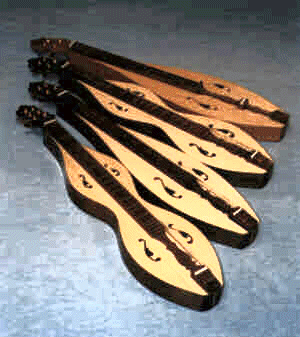
John Stockard

|
Picking Your Picks
John Stockard |
For years I have thought about which pick is the best for a mountain dulcimer player. I became interested in this topic when observing the fact that most beginners use very soft picks and are reluctant to move on to a heavier one. One time a guitar player dropped my house and left behind a very heavy pick. To find out why he used such a heavy pick, I tried it. At first it was difficult to work with, but I stuck with it. As I worked with that pick, I found that my dexterity with it improved and it was great for flat-picking.
This led me to pose the question "What picks do you use for playing dulcimer?" on the Sweet Music Digest mountain dulcimer Internet discussion list. This started a storm of answers. Many people proposed brand names and retail outlets at which they were sold. This was anything but a scientific study of picks, but some basic facts can be gleaned from all that I read.
The Herdim pick was mentioned the most. Some people liked them, others hated them. Many were indifferent. Apparently the Herdim pick has three points, each with different weight or strength. Most people said that they used the heavy point on these picks. Herdims seem to be readily available, especially at dulcimer festivals although they are priced above your average pick because they are imported from Germany.
A constant among the really good players is their penchant for heavy picks -- around one mm. Many of these players said that they use a heavy pick for flat-picking and a slightly softer pick (.5 to .6 mm) for strumming. You may want to carry a selection of picks of different weights and see what you prefer.
I for one have been experimenting with a heavy pick. I use a lime green 88mm pick from Martin Guitar. Not only is it heavy, when dropped it can easily be found (hence lime green). After using this pick for six months I learned that, like the heavy pick from my guitar-playing friend, it is wonderful for flat-picking. The articulation is simply great! It also produces good sound volume, something most dulcimer players could use more of. And, strangely enough, I can't go back to a softer pick. So I play mostly a combination of flat-picking and strumming. Now I use it all the time. I've made my peace with this pick.
Finger picks were not mentioned much and I don't personally know much about them. I do know that a lot of players simply use their fingers. But the Alaska finger picks seem to be a favorite and brass banjo picks are also well-liked.
Beginners: It is my opinion that, once you come to terms with the basic strum, work your way up to the heavier picks. Your precision and musical quality will vastly improve. You may want to do this gradually, incrementally. No need to spend a lot of money on a pick (like $1!). After all, plastic is plastic. The good old Fender medium is many people's stock in trade.
When you find the pick you like, buy a bunch. Then you won't be without one. But if you only have one, don't lend it! Although they are impossible to see, picks have legs.
Remember, you will improve as a dulcimer player
if you try new things from time to time -- new types of picks,
strings, playing techniques, tunings, musical styles, etc. Look
to others for new ideas, and enjoy what you do!

John Stockard is a luthier living in Milledgeville, Georgia. Do you have comments or questions about his article? Contact Mr. Stockard directly by e-mail. To learn more about him, see the Contributors section of Sweet Music Index.
